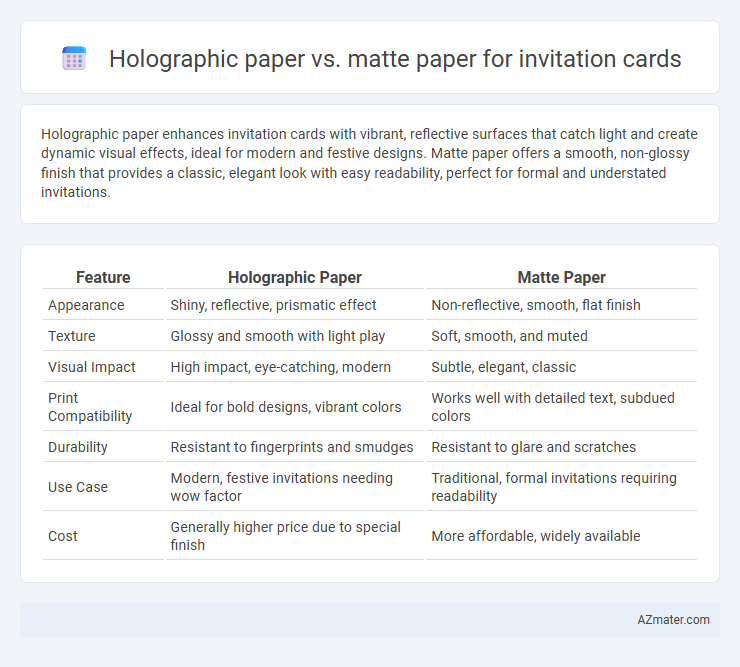Holographic paper enhances invitation cards with vibrant, reflective surfaces that catch light and create dynamic visual effects, ideal for modern and festive designs. Matte paper offers a smooth, non-glossy finish that provides a classic, elegant look with easy readability, perfect for formal and understated invitations.
Table of Comparison
| Feature | Holographic Paper | Matte Paper |
|---|---|---|
| Appearance | Shiny, reflective, prismatic effect | Non-reflective, smooth, flat finish |
| Texture | Glossy and smooth with light play | Soft, smooth, and muted |
| Visual Impact | High impact, eye-catching, modern | Subtle, elegant, classic |
| Print Compatibility | Ideal for bold designs, vibrant colors | Works well with detailed text, subdued colors |
| Durability | Resistant to fingerprints and smudges | Resistant to glare and scratches |
| Use Case | Modern, festive invitations needing wow factor | Traditional, formal invitations requiring readability |
| Cost | Generally higher price due to special finish | More affordable, widely available |
Introduction: The Importance of Invitation Card Material
Invitation card material significantly impacts the recipient's first impression and reflects the event's tone and quality. Holographic paper offers a vibrant, eye-catching surface with iridescent effects that enhance visual appeal and convey a modern, festive atmosphere. Matte paper provides a smooth, non-reflective finish that exudes elegance and sophistication, often preferred for formal or classic invitations.
What is Holographic Paper?
Holographic paper is a specialty material featuring a multi-dimensional, rainbow-like surface created by micro-embossed patterns that reflect light at varying angles, offering a dynamic and eye-catching effect for invitation cards. This paper enhances visual appeal through its iridescent shimmer and holographic foil accents, making invitations stand out in formal events like weddings or corporate celebrations. Compared to matte paper, which provides a smooth, non-reflective finish ideal for a subtle and elegant look, holographic paper delivers vibrant, luminous qualities that capture attention and convey a sense of luxury and festivity.
What is Matte Paper?
Matte paper is a non-glossy, smooth-textured paper that reduces glare and fingerprints, making it ideal for invitation cards requiring a classic and elegant look. Its muted finish enhances readability and provides a sophisticated backdrop for printed text and intricate designs. Compared to holographic paper, matte paper offers a more understated, timeless aesthetic without reflective or shimmering effects.
Visual Appeal: Shimmer vs. Subtle Elegance
Holographic paper offers a shimmering, eye-catching visual appeal with its reflective surface that enhances colors and creates a dynamic, festive look ideal for vibrant invitation cards. In contrast, matte paper provides subtle elegance through a smooth, non-reflective finish that exudes sophistication and a timeless charm suitable for formal or minimalist designs. The choice between holographic and matte paper significantly impacts the invitation's aesthetic, with holographic emphasizing brilliance and attraction, while matte emphasizes understated refinement.
Texture and Feel: Touch Sensations Compared
Holographic paper offers a smooth, glossy texture with a reflective surface that catches light, creating a dynamic, eye-catching feel ideal for modern and vibrant invitation cards. Matte paper provides a soft, non-reflective finish with a slightly textured surface, delivering a sophisticated, elegant feel that is often preferred for formal or classic invitations. The tactile experience of holographic paper is sleek and shiny, whereas matte paper feels gentle and substantial, influencing the overall impression of the invitation.
Print Quality and Color Vibrancy
Holographic paper enhances invitation cards with a reflective, shimmering finish that intensifies color vibrancy and provides a dynamic visual effect, making designs stand out dramatically. Matte paper offers a smooth, non-glossy surface that produces crisp print quality with subdued, elegant colors, ideal for a sophisticated and understated look. Choosing between holographic and matte paper depends on whether you prioritize eye-catching brilliance or refined, muted tones for your invitation cards.
Durability and Practicality in Invitation Cards
Holographic paper offers enhanced durability with its resistant surface that prevents wear and tear, making it ideal for long-lasting invitation cards exposed to frequent handling. Matte paper provides a practical, non-reflective finish that resists fingerprints and smudges, ensuring clear readability and a sophisticated look. For invitations requiring both aesthetic appeal and resilience, holographic paper stands out, while matte paper suits those prioritizing ease of writing and understated elegance.
Cost Comparison: Holographic vs. Matte Paper
Holographic paper for invitation cards generally costs 2 to 3 times more than matte paper due to its specialized manufacturing process and vibrant reflective finish. Matte paper offers a budget-friendly option with a smooth, non-glossy surface ideal for minimalist and elegant designs. Businesses and individuals seeking luxury or eye-catching effects often invest in holographic paper despite the higher price, while matte paper remains popular for cost-effective and classic invitations.
Suitable Occasions for Each Paper Type
Holographic paper suits celebratory events like weddings, birthdays, and parties due to its eye-catching, reflective surface that adds a touch of glamour and excitement. Matte paper is ideal for formal occasions such as corporate events, business invitations, and elegant ceremonies, offering a smooth, non-reflective finish that conveys sophistication and clarity. Choosing between these papers depends on the tone of the event, with holographic paper enhancing festive atmospheres and matte paper supporting refined, professional presentations.
Making the Right Choice: Factors to Consider
Choosing between holographic paper and matte paper for invitation cards depends on the event's tone, design complexity, and desired visual impact. Holographic paper offers vibrant, reflective surfaces best suited for modern, festive occasions and can enhance intricate patterns with dynamic light play, while matte paper provides a smooth, non-reflective finish ideal for elegant, understated, or formal invitations emphasizing text readability and a classic aesthetic. Consider factors such as lighting conditions, printing technique compatibility, and guest preferences to ensure the paper type complements the overall invitation design and event theme.

Infographic: Holographic paper vs Matte paper for Invitation card
 azmater.com
azmater.com